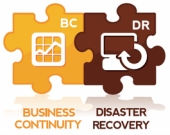 We never really know when a disaster will happen. We don’t know what kind of disaster it will be or how it will occur. Since disasters tend to be unpredictable, the best approach is to prepare and plan for disaster recovery. Information technology is a vital part of every organization, so IT disaster recovery should be considered as part of the overall business continuity plan. I hope this article will help you ask the key questions, and get you started with the disaster recovery planning process.
We never really know when a disaster will happen. We don’t know what kind of disaster it will be or how it will occur. Since disasters tend to be unpredictable, the best approach is to prepare and plan for disaster recovery. Information technology is a vital part of every organization, so IT disaster recovery should be considered as part of the overall business continuity plan. I hope this article will help you ask the key questions, and get you started with the disaster recovery planning process.
How do we operate during and recover from a disaster? The answer to this question varies depending on what kind of plan is in place to recover from a disaster.
Here are few questions to think about in terms of recovering your IT systems from when disaster strikes.
- What is the cause of the disaster? Was the issue with hardware, software or some type of natural disaster?
- If a disaster happens, how long can your organization run without IT resources? What is the acceptable business continuity time?
- Do you have a good backup system in place?
- How soon can your organization recover from the disaster? Does your backup system allow your business to recover within your organization’s business continuity plan?
- Who is responsible for executing the recovery plan?
- Has the recovery plan been tested?
These questions will help you start to think about the different elements involved in creating a disaster recovery plan.
Generally, operating and recovering from an IT disaster would include the following:
- Identifying what are the priority and business critical resources that would need to be recovered? For example, if an organization lost all of its IT systems what should be resorted first.
- Once identified, we need to figure out what are the options to restore those systems? For example, if you decide to restore your email system first, you will need to determine whether it should be restored from a backup system or from a hosted solution? The next question may be who should have email restored first.
A similar process can be used for restoring your other IT systems. Once you have a plan, be sure to test the recovery plan to make sure it works the way you would like it to work.I hope that this blog post helps you to start thinking about your organizations’ IT and disaster recovery plan in conjunction with your overall business continuity plan.Does your organization have a disaster recovery plan? What is your current backup system? Feel free to comment below to share your questions and comments.
>> Resource: Disaster Planning & Recovery, TechSoup
